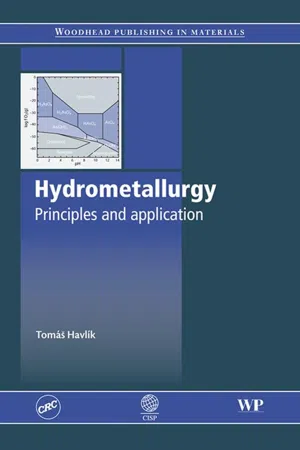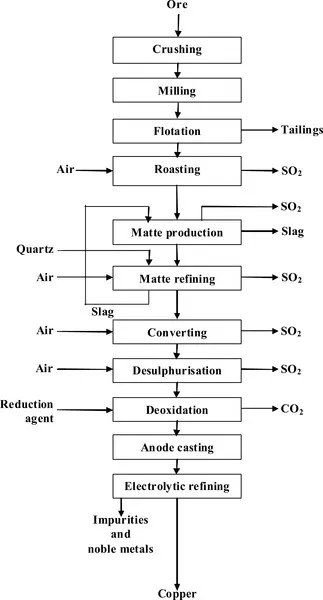
- 552 pages
- English
- ePUB (mobile friendly)
- Available on iOS & Android
eBook - ePub
About this book
This book is concerned with the theoretical principles of hydrometallurgical processes and engineering aspects. The hydrometallurgical processes of production of copper are discussed and leaching of chalcopyrite as the main sulphide mineral of copper processed in industry is used as an example. The book is suitable as a university textbook for students of metallurgy.
- Examines the different techniques involved
- Discusses the production of specific metals using hydrometalluric processes
- Looks at the future of hydrometallurgy
Frequently asked questions
Yes, you can cancel anytime from the Subscription tab in your account settings on the Perlego website. Your subscription will stay active until the end of your current billing period. Learn how to cancel your subscription.
No, books cannot be downloaded as external files, such as PDFs, for use outside of Perlego. However, you can download books within the Perlego app for offline reading on mobile or tablet. Learn more here.
Perlego offers two plans: Essential and Complete
- Essential is ideal for learners and professionals who enjoy exploring a wide range of subjects. Access the Essential Library with 800,000+ trusted titles and best-sellers across business, personal growth, and the humanities. Includes unlimited reading time and Standard Read Aloud voice.
- Complete: Perfect for advanced learners and researchers needing full, unrestricted access. Unlock 1.4M+ books across hundreds of subjects, including academic and specialized titles. The Complete Plan also includes advanced features like Premium Read Aloud and Research Assistant.
We are an online textbook subscription service, where you can get access to an entire online library for less than the price of a single book per month. With over 1 million books across 1000+ topics, we’ve got you covered! Learn more here.
Look out for the read-aloud symbol on your next book to see if you can listen to it. The read-aloud tool reads text aloud for you, highlighting the text as it is being read. You can pause it, speed it up and slow it down. Learn more here.
Yes! You can use the Perlego app on both iOS or Android devices to read anytime, anywhere — even offline. Perfect for commutes or when you’re on the go.
Please note we cannot support devices running on iOS 13 and Android 7 or earlier. Learn more about using the app.
Please note we cannot support devices running on iOS 13 and Android 7 or earlier. Learn more about using the app.
Yes, you can access Hydrometallurgy by T Havlik in PDF and/or ePUB format, as well as other popular books in Technology & Engineering & Mining Engineering. We have over one million books available in our catalogue for you to explore.
Information
Chapter 1
Current Situation in Copper Production
Copper has always played a significant role in the history of mankind and directed development so significantly that one entire era of the development of mankind is referred to as the Bronze Age. Figure 1.1 shows the history of application of copper and copper alloys BC.

Fig. 1.1 Historic review of the application of copper and copper alloys.
At the present time, the amount of copper produced annually is approximately 12 000 kt and continuously increases. Figure 1.2 summarises the trend in the increase of production of refined copper on the worldwide scale. However, this trend does not take into account the production of copper in the countries of the former Eastern Bloc [1].

Fig. 1.2 Development of production of refined copper worldwide.
The current production of copper is concentrated mainly in the processing of sulphide (mostly chalcopyrite or mixed) concentrates by the pyrometallurgical method. The method consists of two operations: melting, including the production of raw copper, and refining, ensuring the production of refined metal with the purity of at least 99.9% Cu.
The pyrometallurgical production of copper (general flow chart is shown in Fig. 1.3) includes the following operations of production of pure copper from sulphide concentrates.

Fig. 1.3 General scheme of pyrometallurgical production of copper.
Roasting. The sulphide concentrate is roasted at a strictly controlled temperature with limited access of air in order to remove part of sulphur by roasting. Subsequently, the resultant roasted product is melted. At present, the roasting process is no longer used in pyrometallurgical production of copper because of the introduction of advanced autogenous processes.
Production of matte. In this operation, the roasted product is melted in a shaft furnace at a temperature of approximately 1200 °C, resulting in melting of the sulphides and the formation of the so-called copper matte. The molten tailings form a slag in the presence of slag-forming additions, enabling separation of undesirable impurities.
Refining of the matte. The copper matte is in fact a melt of copper and iron sulphides. The iron is separated in processing in a converter by blowing air with oxygen, or pure oxygen, resulting in the oxidation of iron because of its higher affinity to oxygen and subsequent transfer of the iron oxide into the slag in the presence of slag-forming additions.
Convertering. In a converter, sulphide sulphur is removed by blowing air or oxygen into the melt, and sulphur reacts to form volatile oxides and copper is transferred into converter copper.
Fire refining. The aim of this operation is to remove the residual sulphur in a rafination furnace in two stages: in the first stage, sulphide is oxidised into volatile oxides by air or enriched air, and the second stage is characterised by the removal of the oxygen bonded with a metal in the first period, using birch logs, or with gaseous hydrocarbons. This operation is referred to as pooling.
Electrolytic refining. In this operation, all the residual impurities are removed from copper by electrolysis. Many of these impurities, trapped in the so-called anode sludge, are important components and, consequently, the anode sludge is further treated in order to recover them. Electrolytic refining results in the removal of impurities such as silver, gold, platinum metals, selenium, tellurium, nickel, arsenic, bismuth, lead, etc.
Although the general flow chart of pyrometallurgical production of copper, shown in Fig.1.3, is relatively simple and cheap and has been used for many years, it greatly differs from optimum requirements. The most important shortcomings include:
Unsuitable thermal balance. Some of the processes, such as roasting, matte refining and converter treatment, are exothermic, whereas matter formation is endothermic. The heat, generated by exothermic processes, is not utilised in endothermic processes resulting in an unsuitable thermal balance. However, in modern practices, oxidising smelting in suspension or bath smelting reactors, roasting, matte formation and separation take place in the same unit and in connection with each other and the whole process is highly exothermic.
Unsuitable design of the system. The flame furnaces are far less efficient than the shaft furnaces from the viewpoint of the transfer of heat and matter. They do not ensure efficient contact of the hot gases with the charge and produce excessive amounts of flue dust, carried away by the gases, because of the use of the dust charge.
Ineffective manipulation with materials. The liquid converter slag is usually recycled in the flame furnace in order to remove copper from the slag. Since the slag contains a large amount of magnetite, the gradual buildup of the latter requires, after some time, shutting down the furnace and the removal of magnetite.
Contamination of the environment. The copper melting plants produce large amounts of sulphur oxides emitted into the atmosphere. Whilst the sulphur dioxide, formed in roasting and converter treatment, is relatively concentrated and may be used for the production of sulphuric acid, the sulphur dioxide formed in the flame furnace is characterised by a low concentration (0.1–0.2%). The latter is processed either to produce sulphuric acid or is neutralised with limestone. The large volume of the gases, emitted into the atmosphere from this source, is a serious environmental problem.
Copper losses. The copper losses into the slag in the flame furnace are proportional to the richness of the matte. Therefore, in order to minimise the losses, copper-rich matte is used only seldom.
Processing and liquidation of waste. The metallurgical production of copper is characterised by the formation of very large amounts of slags with very large quantities of copper. However, the concentration of copper is low and this pre...
Table of contents
- Cover image
- Title page
- Table of Contents
- Copyright page
- Dedication
- Introduction
- Chapter 1: Current Situation in Copper Production
- Chapter 2: Ore Minerals
- Chapter 3: Phase Equilibrium of Copper Iron Sulphides
- Chapter 4: Equilibrium in Aqueous Solutions
- Chapter 5: Thermodynamic Studies of Heterogeneous Systems in an Aqueous Medium
- Chapter 6: Software Databases for Thermodynamic Calculations
- Chapter 7: Kinetics of Heterogeneous Reactions of Leaching Processes
- Chapter 8: Leaching in Chloride Media
- Chapter 9: Extracting Metals From Solutions
- Chapter 10: Effect of The Electronic Structure on leaching of Sulphide Semiconductors
- Chapter 11: Experimental Methods of Investigating Hydrometallurgical Processes
- Chapter 12: Leaching of Copper Sulphides
- Chapter 13: Morphology and Behaviour of Sulphur in the Leaching of Sulphides
- Chapter 14: Study of the Fine Structure
- Chapter 15: Mechanism of Leaching of Copper Sulphides in an Acid Medium
- Chapter 16: The Current State and Prospects of Hydrometallurgical Processes
- Index